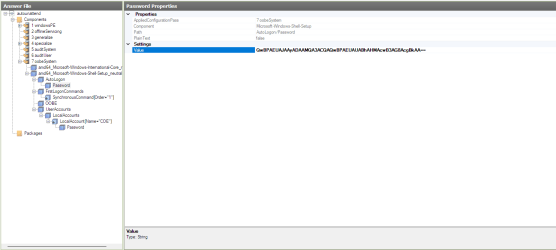First, I hope that this was just a typo:I used " Fully Unattended Installation, Creates Recovery Partition Last "
and i run into an error as below, Any Help Please
Windows could not parse or process unattend answer file
[C:\\Windows\Panther\unattend.xml] for pass [oobeSystem].
The settings specified in answer file cannot be applied.
The error was detected while processing setting for
component [Microsoft-Windows-Shill-Setup].
The error was detected while processing setting for
component [Microsoft-Windows-Shill-Setup].
Notice that the error references "Shill-Setup". That should be "Shell" (with an e rather than an i). I hope that you typed this manually. If not, make sure that this is correct in your real answer file.
Also, I notice that the path being referenced is "C:\\Windows\Panther\unattend.xml". The answer file as I have created it is intended to be place onto the root of your installation media and saved as autounattend.xml, not unattend.xml.
If you have made any changes to the answer file, could you post a copy of the file as you are using it here? This would allow me to test it to see if I can figure out where the problem is.
At this point I feel that it would be good to explain what the difference between the autounattend.xml and the unattend.xml file is:
-----
What is the difference between the autounattend.xml and the unattend.xml answer files?
autounattend.xml - This file deals with the information needed by Windows to understand how to install Windows, the critical pieces of information needed to setup Windows. For example, what disk should Windows be installed on, how should that disk be partitioned, etc.
unattend.xml - This file deals mainly with the OOBE (Out Of Box Experience). In other words, once the basic installation is done and Windows is booted for the first time after the initial installation, this file applies customizations to Windows. For example, it changes the computer name to the name you specify, it sets OEM information for the system, allows you to bypass the EULA, create user accounts, etc.
Note that the unattend.xml file is only used if you create a reference system. You can take most of the settings that are in the unattend.xml file and place them in the autounattend.xml if you do not want to create a reference system.
-----
After you check the above, if you are still having difficulties, please post a copy of your answer file if you have made any changes to it so that I can test if to see if I have any difficulties with it.
Have you also made sure that in your system, the drive to which Windows should be installed onto is drive number 0 (zero)? On some systems, this needs to be changed. On my primary desktop PC, as an example, Windows is installed on disk 2. You can verify this like this:
Boot from your Windows installation media WITHOUT AN ANSWER FILE. At the first static screen where Windows setup stops tomask you for information, press SHIFT + F10 to open a command prompt. Run DISKPART. Within diskpart, do a "list disk". Hopefully from the information displayed you can determine which disk is the one to which Windows needs to be installed. Make note of that drive number. That is the drive number to use in the answer file. Note that if you need more info on a drive to determine if it is the correct drive, you can do this:
select disk 0
detail disk
Repeat the above commands for disk 1, 2, etc. as needed.
When done, type "exit" to exit from diskpart and then reboot your system.
If this still does not help, please let me know and I will help further.
My Computers
System One System Two
-
- OS
- Win11 Pro 24H2
- Computer type
- PC/Desktop
- Manufacturer/Model
- Self-built
- CPU
- Intel i7 11700K
- Motherboard
- ASUS Prime Z590-A MB
- Memory
- 64GB (Waiting for warranty replacement of another 64GB for 128GB total)
- Graphics Card(s)
- No GPU - Built-in Intel Graphics
- Sound Card
- Integrated
- Monitor(s) Displays
- HP Envy 32
- Screen Resolution
- 2560 x 1440
- Hard Drives
- 1 x 1TB NVMe SSD
1 x 2TB NVMe SSD
1 x 4TB NVMe SSD
3 x 512GB 2.5" SSD
1 x 4TB 2.5" SSD
5 x 8TB Seagate Barracuda HDD
- PSU
- Corsair HX850i
- Case
- Corsair iCUE RGB 5000X mid tower case
- Cooling
- Noctua NF-S12A chromax.black.swap case fans (Qty. 7) & Home Computer Specifications, Configuration, and Usage Notes General Specifications ASUS Prime Z590-A motherboard, serial number M1M0KC222467ARP Intel Core i7-11700K CPU (11th Gen Rocket Lake / LGA 1200 Socket) 128GB Crucial Ballistix RGB DDR4 3200 MHz DRAM (4 x 32GB) Corsair iCUE RGB 5000X mid tower case Noctua NH-D15 chromax.black CPU cooler Noctua NF-S12A chromax.black.swap case fans (Qty. 7) & Corsair LL-120 RGB Fans (Qty. 3)
- Keyboard
- Corsair K70 Max RGB Magnetic Keyboard
- Mouse
- Logitech MX Master 3
- Internet Speed
- 1Gb Up / 1 Gb Down
- Browser
- Edge
- Antivirus
- Windows Defender
- Other Info
- The five 8TB drives and three 512GB SSDs are part of a DrivePool using StableBit DrivePool software. The three SSDs are devoted purely to caching for the 8TB drives. All of the important data is stored in triplicate so that I can withstand simultaneous failure of 2 disks.
Networking: 2.5Gbps Ethernet and WiFi 6e
-
- Operating System
- Win11 Pro 23H2
- Computer type
- Laptop
- Manufacturer/Model
- Lenovo ThinkBook 13x Gen 2
- CPU
- Intel i7-1255U
- Memory
- 16 GB
- Graphics card(s)
- Intel Iris Xe Graphics
- Sound Card
- Realtek® ALC3306-CG codec
- Monitor(s) Displays
- 13.3-inch IPS Display
- Screen Resolution
- WQXGA (2560 x 1600)
- Hard Drives
- 2 TB 4 x 4 NVMe SSD
- PSU
- USB-C / Thunderbolt 4 Power / Charging
- Mouse
- Buttonless Glass Precision Touchpad
- Keyboard
- Backlit, spill resistant keyboard
- Internet Speed
- 1Gb Up / 1Gb Down
- Browser
- Edge
- Antivirus
- Windows Defender
- Other Info
- WiFi 6e / Bluetooth 5.1 / Facial Recognition / Fingerprint Sensor / ToF (Time of Flight) Human Presence Sensor








